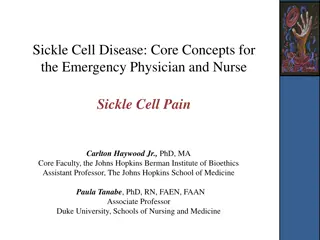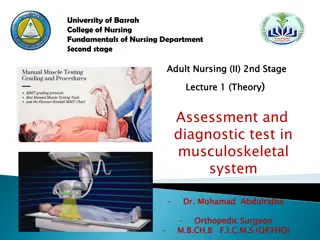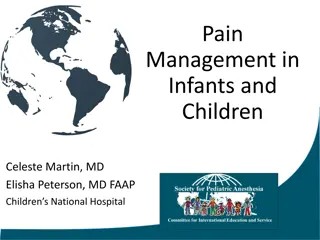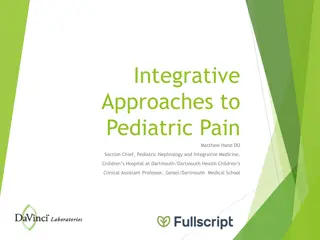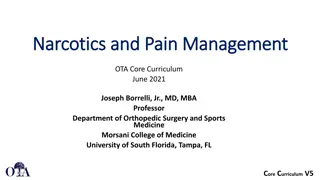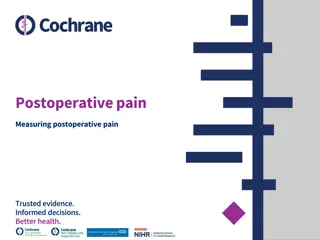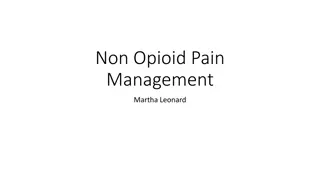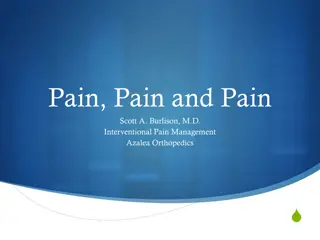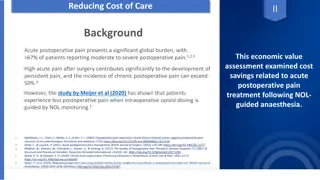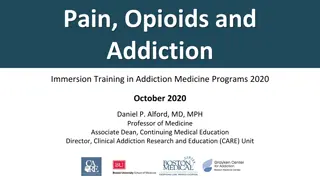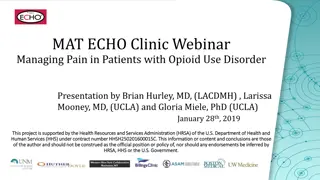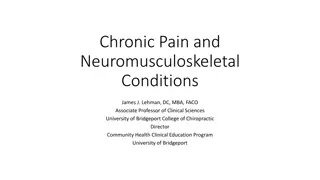Physiology of Pain
An exploration of pain physiology, covering topics such as types of pain receptors, neural pathways, perception of pain in the brain, and methods of pain measurement. The content delves into fast and slow pain, pain stimuli, pain receptors, and factors influencing pain sensitivity. Visual aids and definitions are provided to enhance comprehension.
Download Presentation

Please find below an Image/Link to download the presentation.
The content on the website is provided AS IS for your information and personal use only. It may not be sold, licensed, or shared on other websites without obtaining consent from the author.If you encounter any issues during the download, it is possible that the publisher has removed the file from their server.
You are allowed to download the files provided on this website for personal or commercial use, subject to the condition that they are used lawfully. All files are the property of their respective owners.
The content on the website is provided AS IS for your information and personal use only. It may not be sold, licensed, or shared on other websites without obtaining consent from the author.
E N D
Presentation Transcript
Physiology of Pain Dr Abdulrahman Alhowikan Collage of medicine Physiology Dep.
After the lectures student should be able to: To know about the receptor of pain. The types of neuron responsible for conduction of impulses e.g A-delta andC- types. Two types of pain e.g fast and slow. Know the tracts involved and its functions. Know the role of thalamus and cortex in the perception of pain.
Definitions: An unpleasant sensory and emotional experience associated with actual or potential tissue damage. Pain occurs whenever tissues are being damaged, and it causes the individual to react to remove the pain stimulus !!! Measuring the pain ???
Visual Analogue Scale (VAS) is a subjective measure of pain. baseline assessment of pain with follow-up
Fast pain or (sharp pain, pricking pain, acute pain, and electric pain) felt within about 0.1 second after a pain stimulus is applied Absent in most deeper tissues of the body Eg. Skin cut with a knife, needle slow pain (slow burning pain, aching pain, throbbing pain, nauseous pain, and chronic pain) begins only after 1 second or more and then increases slowly over many seconds and sometimes even minutes.
The pain receptors widespread in the superficial layers of the skin and internal tissues, such as the periosteum, the arterial walls, the joint surfaces, Types of Stimuli Excite Pain: thermal, and chemical pain stimuli fast pain: elicited by the mechanical and thermal stimuli slow pain: can be elicited by all three types of stimuli. The pain receptors: all free nerve endings Types of Stimuli Excite Pain: mechanical,
If pain stimulus continues. This increase in sensitivity of the pain receptors is called hyperalgesia hyperalgesia keep the person apprised of a tissue-damaging e.g slow-aching-nauseous pain Rate of Tissue Damage as a Stimulus for Pain E.g if skin is heated above 45 C Chemical Pain Stimuli During Tissue Damage bradykinin might be the agent most responsible for causing pain following tissue damage or enhance the sensitivity of pain endings
Tissue Ischemia as a Cause of Pain lead to (accumulation of large amounts of lactic acid and bradykinin ) E.g 1-blood flow to a tissue is blocked 2-Exercise of muscles cause muscle pain within 15 to 20 s Muscle Spasm as a Cause of Pain: !!!Due to 1- direct by stimulating mechanosensitive pain receptors 2-indirect due to ischemia
two separate pathways: fast-sharp pain pathway elicited by mechanical or thermal stimuli transmitted in the peripheral nerves by small type A fibers at velocities 6 - 30 m/sec. slow-chronic pain pathway elicited mostly by chemical stimuli but sometimes by mechanical or thermal stimuli. transmitted to the spinal cord by type C fibers at velocities 0.5 - 2 m/sec.
consequently, Fast and slow entering the spinal cord the pain signals take two pathways to the brain (1) neospinothalamic tract (2) paleospinothalamic tract.
(1) neospinothalamic tract fast type A pain fibers transmit mechanical and acute thermal pain ( glutamate is the neurotransmitter in the spinal cord terminate mainly in lamina I (lamina marginalis)
(2) the paleospinothalamic tract. transmits pain via slow- chronic type C pain fibers terminate in the spinal cord in laminae II and III (together called substantia gelatinosa however, type C pain fiber release two transmitter glutamate (fast pain) and substance P (slow pain )
the pain nervous pathways can be cut at any points If pain in lower part of the body, a cordotomy in the thoracic region of the spinal cord often relieves the pain for a few weeks to a few months
consists of three components: (1) The periaqueductal gray and periventricular areas of the mesencephalon and upper pons (2) the raphe magnus nucleus, a thin midline nucleus located in the lower pons and upper medulla, and the nucleus reticularis paragiganto cellularis (3) a pain inhibitory complex located in the dorsal horns of the spinal cord.
https://www.youtube.com/watch?v=PMZdkac 4YLk&list=PL696DB7FD0EA1C59E
electrodes are placed on selected areas of the skin or, on occasion, implanted over the spinal cord, supposedly to stimulate the dorsal sensory columns. in appropriate intralaminar nuclei of the thalamus or in the periventricular or periaqueductal area of the diencephalon. The patient can then personally control the degree of stimulation. pain relief has been reported to last for as long as 24 hours after only a few minutes of stimulation.
feels of pain in a part of the body that is fairly remote from the tissue causing the pain E.g pain in one of the visceral organs often is referred to an area on the body surface It is important in clinical diagnosis because in many visceral ailments the only clinical sign is referred pain
Visceral Pain: abdomen and chest, used for diagnosing visceral inflammation visceral pain differs from surface pain: 1- visceral pain localized types of damage to the viscera e.g surgeon can cut the gut surface pain by stimulation of pain nerve endings e.g ischemia caused by occluding the blood supply to a large area of gut Visceral Pain: Pain from viscera of the
Causes of True Visceral Pain Ischemia formation of acidic metabolicor tissue- degenerative products such as bradykinin, proteolytic enzymes Chemical Stimuli substances leak from the gastrointestinal tract into the peritoneal cavity. For instance, proteolytic acidic gastric juice may leak through a ruptured gastric or duodenal ulcer. Spasm of a Hollow Viscus Spasm of a portion of the gut, the gallbladder, a bile duct, a ureter, or any other hollow viscus can cause pain
Overfilling Hollow Viscus because of overstretch of the tissues . May lead to collapse the blood vessels and cause ischemic pain. Insensitive Viscera A few visceral areas are insensitive to pain e.g parenchyma of the liver and the alveoli of the lungs.
visceral pain is referred to the surface of the body, which originated from visceral organ E.g Pain impulses pass first from the appendix then into the spinal cord at about T-10 or T-11; this pain is referred to an area around the umbilicus and is of the aching, cramping type.
Meninges Heart Trachea Diaphragm Oesophagus Stomach, duodenum Upper abdomen, Small bowel, pancrea Around umbilicus Large bowel, bladder Lower abdomen Behind sternum Back of head and neck Central chest arms (usually left), neck, occasionally abdomen. Shoulder tip Behind sternum epigastrium above pubic bone
Hyperalgesia nervous excessively excitable; to hyperalgesia, (hypersensitivity to pain). causes of hyperalgesia : (1) sensitivity of the pain receptors (primary hyperalgesia ) (2) facilitation of sensory transmission, secondary hyperalgesia. Tic Douloureux pain over one side of the face , sudden electrical shocks, for a few seconds Brown-S quard Syndrome if the spinal cord is transected on only one side
Reference book Guyton & Hall: Textbook of Medical Physiology 12E Thank you Thank you
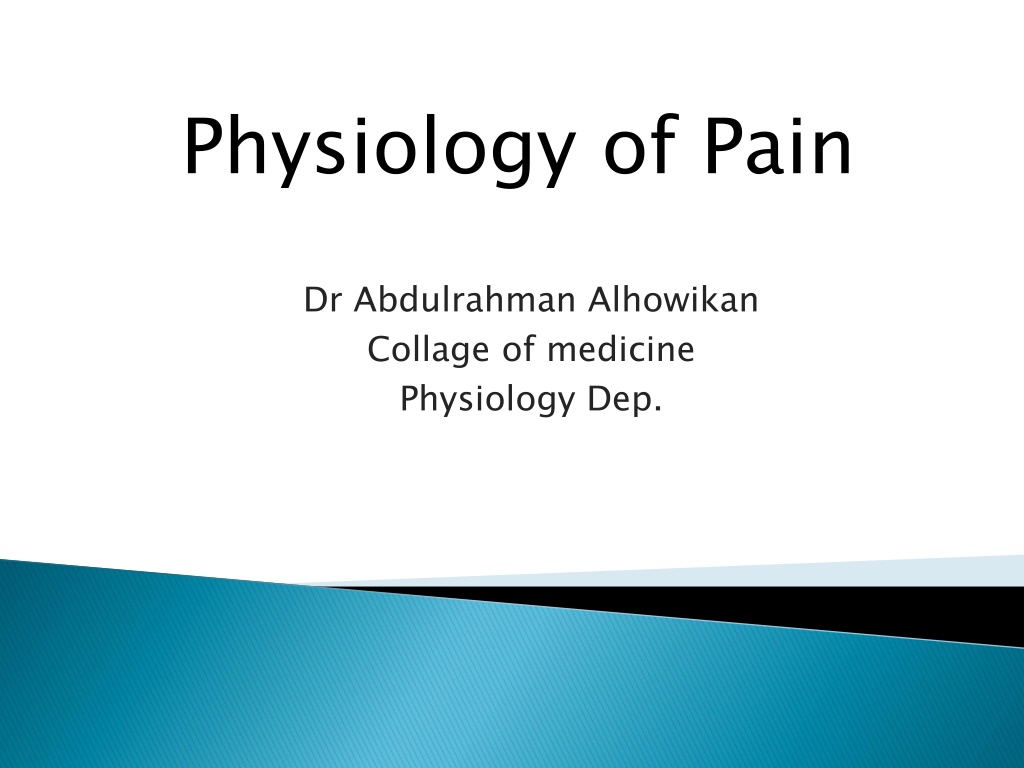
 undefined
undefined



